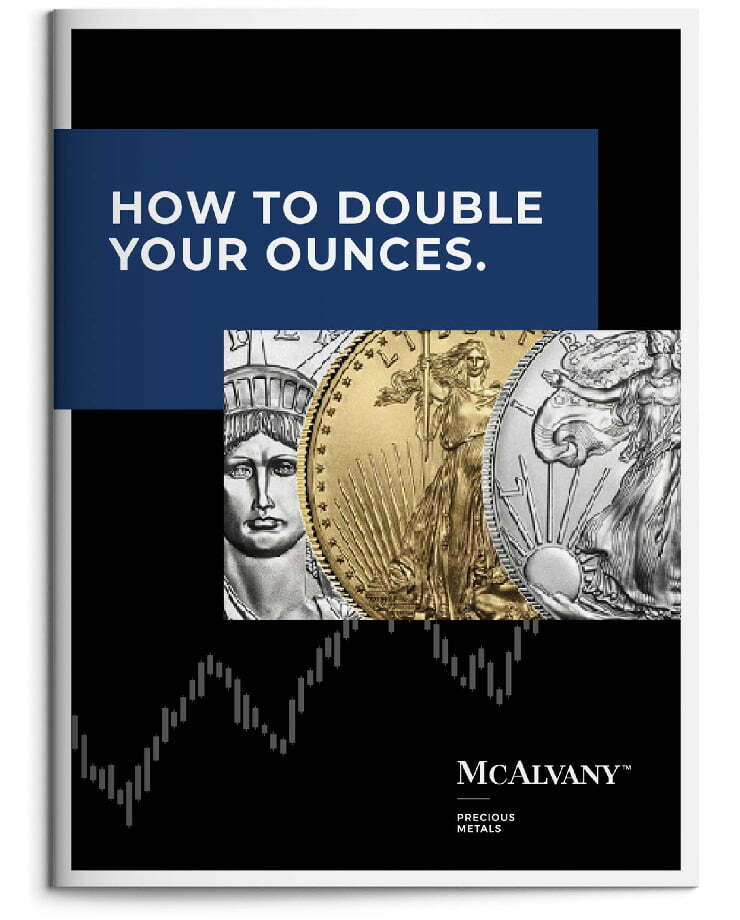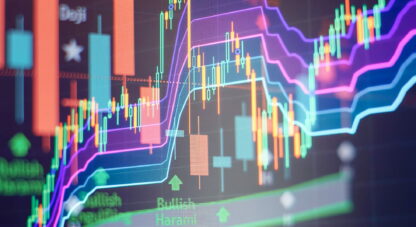Podcast: Play in new window
Are markets really on fire and how high is too high? This week David and Kevin dig into the dizzying climb in valuations, with the Buffett Ratio screaming to a record‑breaking 210%. We explore what that number really means, why China’s debt machine is running out of steam, and how even a Krispy Kreme meme‑stock craze says something about investor psychology in 2025. As always, the discussion ties back to what matters most — how to protect your wealth, where gold fits in, and why perspective is everything when markets feel untouchable. Please register for the upcoming Tactical Short call happening this Thursday, July 31 at 2:00 pm MT, you can register at this link: https://mcalvany.com/wealth/tactical-short-registration/
“It’s the central bank community first and foremost that is acknowledging there is a structural and secular change. We’re lost in the present moment, which is fine. It’s justifiable. You have adequate liquidity, you can justify taking risk today. But current conditions often change. If only they were constant, if only those conditions were sustainable.” —David McAlvany
* * *
Kevin: Welcome to the McAlvany Weekly Commentary. I’m Kevin Orrick, along with David McAlvany.
David, you were telling a story about your dad and it just sounds so typical. Okay, he’s 85 years old. Your mom and your dad live in the Philippines right now, and when they were building their house, they said we want it built higher [off the ground] than everybody else because—
David: It is totally unnecessary. The builder was like, “You know, a foot, two feet, that’s fine.”
Kevin: But Don’s a preparer.
David: Absolutely. So he goes and adds more dirt, more dirt, more dirt. And so you’ve got four typhoons in a row, one week. When it rains it pours, and he’s living on an island. And he loves the island.
Kevin: And who’s dry, who’s dry?
David: Yeah.
Kevin: And actually, in all seriousness, Operation Joseph right now, they’re putting rice bags together for the people who are needing it.
David: It’s a pretty amazing story if you think about these orphans who have the opportunity to put together kilo bags of rice and then give them to the community, people who have nothing, who come from nothing, and they’re now able to take care of the needs of other people.
Kevin: And these are needy orphans. These were orphans that came. They had a need, and now they’re actually meeting a need.
David: Right.
Kevin: Yeah. That’s an amazing thing.
David: But always kind of thinking ahead and considering, what’s the worst case?
Kevin: Right. Well, at least Don and Molly are dry. That’s wonderful. Well, Doug Noland’s going to have his Tactical Short [conference call] coming up here this next week.
David: Yep. Join us for the second quarter 2025, tactical short call. It’s Thursday, 2:00 PM Mountain or 4:00 PM Eastern. And if I were titling this one, it would be something of a parody, Free Money and the Overthrow of the Mithraic tradition.
Kevin: That sounds exactly like you, Dave. That’s a title that— You got to know a little bit about the bull sacrifice of that religion, right?
David: We were in Rome, I don’t know, four or five years ago, just before COVID, and we did an archeological tour of this old church, and three layers down they had unearthed this altar to—
Kevin: Where they sacrificed bulls?
David: Right. In this ancient Roman cult, if you will, and anyways, this is the overthrow of the Mithraic tradition, this is where we kill bears, not bulls.
Kevin: Okay. So when you’re talking about bull, think financial here.
David: Yes, that’s right. So we’ve adapted Edmund Burke’s classic phrase to: all that is necessary for bears to triumph is that good bulls buy nothing. So buy with your own money, buy with margin, buy using credit cards, particularly buy crypto, but do your patriotic and your new religious duty in a financial nod to your side, which is killing of the bear. Go get yourself a good meme stock and ride it to the moon.
Kevin: You’re sounding a little like Tomáš Sedláček when he was talking about the new religion is growth. It’s all growth these days.
David: We’ve concluded that measures of liquidity are just right. 22 trillion, that’s the new measure for M2, bank assets approaching 30 trillion, system-wide credit north of 80 trillion, corporate valuations are now in the sweet spot, particularly for the value investor. Who doesn’t love a price-to-earnings ratio of 41?
Kevin: Yeah. Nothing to see here.
David: Central banks are perfectly threading the needle with monetary policy, particularly in the UK. And fiscal stimulus and debt financing have a lot more latitude from here if we could just get Powell to lower interest rates. That’s what he can bring to the potluck. In fact, in fact, economists have a new equation that opens the door to supporting $100 trillion in national debt supported by benign inflation targeting still in the single digits. We’re calling 9% benign. Isn’t 9 so benign. So join us for the Tac Short call. You’ll enjoy confessions, Mea culpa’s, newfound expression of faith in credit. Join us Thursday, followed by Q&A and a credit altar call.
Kevin: Well, this is seeing the world through free money. Free money is forevermore.
David: Through the lens of free money, we’ve been uplifted, we’ve been liberated. And with our fresh insights on Tac Short, I will be introducing a compelling buy list, an allocation suggestion for the remainder of 2025. We should short gold forever, not just now, but forever. Buy CCC-rated corporate debt. That’s the lowest junk rated debt on the market.
Kevin: Yeah, but why worry?
David: Add leverage, margin your positions, and make sure you buy plenty of micro strategy, now just called strategy, if you want leveraged exposure to crypto. It’s the only way to go. Nvidia, join the $1 trillion currently borrowed and bullish. FINRA gave out their new numbers, a trillion dollars in margin debt. New record. Get special access to an asset class. I feel like we owe it to our customers, our listeners, to let them know where they should be putting money.
Kevin: Well, the religion of perpetual growth-
David: And I can think of no better place, no better place than an asset class that is no longer limited to the ultrahigh net worth. It’s perfectly crafted, democratized, we’ll call it democratized. An ETF exposure. You can have both private equity and private credit. And we’re focusing on a rare opportunity, that is a continuation fund, a continuation fund. Ticker symbol is B-A-G as in bag and there’s a second one, H-L-R-D as in holder—
Kevin: Bag holder.
David: My personal favorite if you want to continue the theme with private credit, perfect allocation for every portfolio. Ticker symbol R-E-G-U-R-G, regurg, and there’s another one, FOMO, F-O-M-O, sponsored by RWSO Financial, that’s Running with Sharp Objects Financial.
Kevin: So you’re seeing opportunity?
David: They’re shaping up. Bull market in its infancy has begun. And to please the gods of the marketplace, on the call—on the call, to please the gods of the marketplace—there will be a token sacrifice of a bear. Your side, his back, Sorry, Doug. We rather prefer to extinguish from our mind and all memory the analytical bear, the kind that runs fast, climbs high, and eats raw meat instead of berries and twigs.
And of super significance is we’ll have a live feed, the World Wildlife Fund will be on hand, first televised extinction event. First televised extinction event. Funny, ironic, isn’t it that the same week we see the bear disappear, the price of ground beef reaches all-time highs. We need more bull in our diet. You are what you eat. If that doesn’t make you bullish on America, I don’t know what will. Price action is everything. Good times for the faithful. I’m telling you, good times for the faithful.
Kevin: So you’ll restate Edmund Burke, you’ll restate that again.
David: Yeah. All that is necessary for bears to triumph is that good bulls buy nothing. So buy with your own money, buy with margin, use your credit card, particularly for crypto. Do your patriotic, your new religious, duty in a financial nod to your side, go get yourself a good meme stock and ride it to the moon.
Kevin: Okay. So for the person who doesn’t know when you’re being ironic, sarcastic—
David: It’s too much.
Kevin: —the last three minutes or four minutes of the show was just that, right?
David: This is not financial advice. Seek a financial advisor’s blah-blah-blah.
Kevin: So when this plays on YouTube shorts, you want to make sure that none of this shows up in the shorts or you’ll get kicked in the shorts.
David: Well, so what’s not parody is, it’s true that the Buffett ratio, if we reference the Russell 5,000, Russell 5,000 to GDP has hit its all-time high, 210%. It is true that margin borrowing as reported by FINRA is over a trillion dollars. Previous highs were 935 billion, that was October of 2021, and 937 billion in January of 2025. New all-time highs. It is true that the S&P’s price-to-earnings ratio is tempting, 30, very close to 30. It is true that the Nasdaq’s PE is over 41. Nasdaq 100 is flirting with the mid 40s.
Kevin: Well, and the one that you watch the most is the cyclically adjusted, the CAPE, price-to-earnings ratio.
David: Yep. 38, not to worry. In the year 2000, it was higher by six points. So 44, we’re a long way off from being overvalued.
Kevin: Right before the tech stock bubble blew up.
David: But seriously, 38 is pretty darn high. Price-to-sales, that ratio’s never been higher, over 300%. We could certainly see that 44—going back to the price-to-earnings ratios—we could certainly see that be taken out. You get an upward thrust in price, and we have that energy in the marketplace today.
Kevin: Well, how about donuts? How about donuts these days?
David: Krispy Kreme is back.
Kevin: Yeah.
David: It survived the “I don’t eat sugar anymore, and carbs are for losers.”
Kevin: Right.
David: I mean, it’s amazing. It’s back 60%—
Kevin: Well, nobody’s eating the donuts, they’re just buying the shares.
David: That’s right.
Kevin: Right.
David: So it is true that meme stocks are back, just like 2021. If your company is failing and your short interest is huge, then Reddit readers and day traders are looking to cash in on short covering by forcing you to cover with prices at 25, 50, 100% percent higher in a day.
Kevin: So the guys that manufactured buggy whips a hundred years ago possibly have hope if they go public with their shares.
David: You just have to have a large enough short interest in your shares. You have to be so doomed and it has to be so obvious.
Kevin: Yeah. Get everybody to buy it.
David: That’s right. It’s also true that cash is flowing in record quantities to triple-C corporate debt. That’s the lowest rated junk bonds. And we’ve seen issuance on a daily basis in the tens of billions of dollars into junk paper. The last few weeks have been astounding the amount of money flowing into junk debt. Is there any concern? Absolutely not.
Kevin: Well, you talked about liquidity when you were being ironic and sarcastic, but liquidity really is out there.
David: Yeah. And it is true that continuation funds are now making up close to 50% of private equity deals, allowing for limited partners to exit, get their money out and pass the unsellable to the bag-holding public. We’ve got $3 trillion in assets that is waiting to be brought to market, sliced, diced, remarketed. Nobody wants it. So what do you do? You create a continuation fund and let someone know they are the happy owner of the-I mean, it’s like—
Kevin: It reminds you of mortgages back in the mid 2005, 2006.
David: It reminds me of baloney.
Kevin: Yeah.
David: You don’t really know what’s inside.
Kevin: So make sure you have plenty of mayonnaise.
David: The mystery pink meat. Just add more mayonnaise, you’ll be fine. It’s true that crypto has a beta— Financial Times wrote an article. This was fascinating. Has a beta of 2.6—
Kevin: Explain that. Okay, so a beta of 2.6 is, what is that? Two and a half or 2.6 times the volatility?
David: Any stock that has a beta of one moves in direct lockstep with the stock market.
Kevin: Okay. Okay
David: So 1% up for the stock market, your stock, it’s also going to be up 1%.
Kevin: And crypto is 2.6?
David: 2.6.
Kevin: Okay.
David: Right? So it is far more volatile, both on the upside and the downside. JP Morgan this week is talking about lending on crypto as an asset. So if you’re thinking about, against collateral that is secure, it’s multiples more volatile than stocks.
To me, it’s kind of a sign of the times. It’s true that concentration risk has never been greater, where people are focused on what has been in the rear-view mirror, the winner. So they continue to pile into and load up on the Mag-7. It is true that the markets are wildly bullish and adequately supplied with liquidity to do whatever they want. And it is true that lowering rates would reduce our interest expense. The President is not wrong in saying, “Hey, Jay Powell, lower rates, you could save us a trillion dollars.”
Kevin: Yeah, don’t worry about the inflation.
David: But if you add liquidity to a market that is already on fire, you’re talking about significant danger.
Kevin: Okay, so that’s the financial markets. How about some of the other things that you would add fire to like Epstein?
David: Oh, so salacious. It is true that the Epstein list has more notable politicians and business leaders than the public can handle knowing about, which includes multiple presidents, countless senators, and tech titans, frankly uninterested in seeing their names on the front page of daily papers.
Kevin: And so we won’t.
David: Just ask Bill Gates—
Kevin: Yeah.
David: —how it feels to make the papers. Melinda will probably give you a more honest answer as to what it looks like to navigate those waters.
Kevin: Pay no attention to the man behind—which curtain? Yeah.
David: Or on which island.
Kevin: There you go.
David: It is true that Chinese GDP has averaged 5.3% year to date. Q2, surprisingly strong 5.4%. And it’s also true that the Chinese are running the largest trade surpluses ever. Exports exceeded imports by $114 billion. We haven’t seen those numbers ever. So $325 billion—this is for the month of June—it exports. $210 billion in imports. Which suggests that running the manufacturing sector extra hot and creating excess supply, that’s the ongoing policy choice.
Kevin: And so it’s just make things, even if people aren’t buying them, right?
David: It reflects a refusal of Chinese policymakers to address domestic consumption as the gap between production and consumption continues to grow. And this is even while industrial production grows and profits are falling. And so Michael Pettis is keen to note that—he lives in China. I’m frankly impressed by his candor to talk about economic statistics of a dire nature—
Kevin: Sure.
David: —because it’s generally frowned upon. We report the good news and nothing else. But he’s noted that government officials don’t want to see price competition. And yet they’re creating an environment where you’re oversupplied with product and the only way you can move inventory is to lower prices. So they’re not connecting the dots between, “we don’t want price competition, you shouldn’t be lowering your prices anymore, that’s deflationary ,” and yet they are cranking out product and subsidizing the manufacturing sector like never before.
Kevin: So how do you not have overcapacity when you’re making widgets and nobody’s buying them?
David: You do have overcapacity, and that’s a problem. Inventories are building and they have to clear. So Pettis is unsurprised by the positive GDP results. He points to the quality of growth lacking. It’s driven by supply side in the economy rather than the demand side. And if supply side growth remains the driver of GDP, debt will continue to expand exponentially. This is a problem. This is unsustainable for China. And the same model if you put it in use anywhere else, again, it’s not sustainable. Only during COVID did system financing—that is, if you’re measuring all of the debt and ability for the Chinese to finance in multiple ways—did it grow faster than right now; only once, and that was during COVID.
Kevin: We have asked this question before because during COVID they expanded the debt almost unlimited. I mean it was like, “Okay, do whatever it takes.”
David: Yep.
Kevin: How long does it take before you reach over capacity on debt where you no longer have the capacity to loan?
David: Yeah, that’s the question. Whether it’s China, the U.S., Europe, the question of debt capacity remains firmly fixed, and we don’t know whether we’ve exceeded capacity until the market sends a signal. For a corporation, debt capacity is a function of balance sheet and cash flow measures. And it’s similar for a country, but it’s a little bit different. Corporations don’t have the latitude to print money. They do in the sense that they can issue new shares, they can kind of create their own currency, but not to the extent that a central bank can. And there’s a more immediate effect. If you’re creating too many corporate shares, you’ve diluted the value that existing shareholders believe that they held, and the price goes down.
Kevin: Right.
David: And of course if you’re issuing too much debt, you get a downgrade to your debt, cost of capital goes up, and it’s a bad scenario. For a country issuing too much of its currency or too much credit, it can impact the currency’s value. Or if it’s too much credit, the rate of interest required to pay can end up going higher. Again, if you’re dealing with excess supply, not enough demand, you’re going to drive interest rates higher. And that’s what we’re facing globally, it’s an experiment with debt capacity limits.
Kevin: So they’re trying to find out what’s tolerable. And so far it’s been very tolerable, it just keeps increasing.
David: Testing the outer bounds.
Kevin: Yeah.
David: The larger surprises lurking in the financial markets are reactions to exceeding capacity thresholds. Once exceeded, what are countries supposed to do?
Kevin: Right.
David: Once you go past it, then what do you do? You’ve already issued the idea—
Kevin: You inflate.
David: That’s the classic method.
Kevin: Right.
David: Tinker with your inflation metrics, run inflation hot to pay down the debt. Again, not an option for corporations, but a real temptation for all central banks and treasuries.
Kevin: So the question I have is how much do you have to borrow to have any growth? Okay, so let’s say you have to borrow a little bit of money, even with a business you borrow, but you certainly hope growth exceeds what you borrow.
David: I don’t remember what the numbers are for the United States, but we’ve had conversations about this on the commentary before where it used to be that you added a dollar in debt and you got a dollar of GDP growth.
Kevin: You break even.
David: And it’s basically worth it. The question is, is there diminishing returns over time as you accumulate more debt and it actually takes more to get the same amount of growth—more debt to get the same amount of growth. And in China it takes four Renminbi for one Renminbi of growth.
Kevin: That sounds like a losing strategy.
David: It’s not a good idea. But I want to quote Pettis because he gets to the nub of this, but obviously that’s not tenable. It’s not sustainable to continue to grow debt at four times the pace of economic activity. You can’t do—
Kevin: It’s like bailing water, but you’re not bailing quick enough.
David: Right, right. So to quote Pettis, “China will remind us of something we’ve seen many times before. Rising imbalances and unsustainable economic activity can go much longer than we expect, mainly because the structural adjustments needed to reverse them are politically more difficult than most economists realize. But when they do reverse, the adjustment is often more painful and surprising than anyone expected.”
Kevin: Okay, but it’s different for each country.
David: Each country has its own debt capacity limits. Each country today has its own unique imbalances. The uniform characteristic is leverage in the financial system, in each of those financial markets. Another uniform characteristic is the requirement of credit growth for economic growth.
And this goes back to changing the system in the 1970s where we had a limit on credit growth because we had a limit in the quantity of money—ultimately because you were limited by your reference being gold. You remove the reference to gold, you remove any limit to the quantity of money, and now you can create as much money and credit as you want. And the temptation was, with more credit comes more growth.
Kevin: Right.
David: What we’ve seen and what Pettis gets at with China is, yes, but you have to have the right quality of growth. It can’t just be any sort of growth. And what they’ve substituted is the merchant and the manufacturer for the real estate developer, which is in complete failure.
Kevin: A bit like World War II. Hasn’t the excuse in the past for that removal of limits been something like a war where you just don’t have time to worry about GDP growth. You’ve got to build carriers and battleships.
David: Right. And so there are periods of time where you’ll see debt to GDP explode higher for a year or two. But you go back in the United States, we hit $1 trillion in debt for the first time in 1941.
Kevin: Right, when we went to war. Yeah.
David: 10 trillion in 1995. 20 trillion in 2011. 30 trillion in 2020, and we’re on track for 40 trillion by 2026.
Kevin: And the elimination of the gold standard is what allowed that to happen.
David: It has sped the process—
Kevin: Right.
David: —because obviously you can have as much credit as you want, as long as the markets will tolerate it. And US debt to GDP— So those are the debt figures from one to 40 trillion in the time frame of 1941 on a much more aggressive pace. I mean, it’s less than 10 years now that it’s taking for us to add the next 10 trillion.
US debt to GDP spent the decades of the ’60s, ’70s, and ’80s under 50% debt to GDP. The debt was less than GDP, a bigger engine for a smaller amount of debt obligations. That accelerated to 65% in the 1990s. Accelerated further to 80% during the global financial crisis. 100% as recently as 2012, and currently sits at just over 120% to GDP.
Kevin: So that’s the bailing out again. It’s—
David: Yeah, it’s accelerating—
Kevin: —120% of GDP. Yeah.
David: Yeah, it’s accelerating faster than the economic engine. We have more debt than we do engine. So the burden of carrying— I mean, if you think about horsepower in a car, like a simple truck. A simple truck can carry a half ton if it’s a half ton truck or a one ton truck or what have you. But you start putting five tons on a half ton, and all of a sudden—
Kevin: It backs up down the hill.
David: It’s not engineered to carry— You’ve got something that has the ability to move, but it wasn’t engineered, it wasn’t designed for that. It’s too much of a burden relative to the engine.
Kevin: Yeah. So what you’re saying is the US credit growth, okay, this debt to GDP thing, it’s not as extreme as China, but it’s not good.
David: Well, it’s not good. I mean, it was 2014, we had Reinhart and Rogoff, right? This Time It’s Different.
Kevin: I love that book.
David: The book that lays out why 90% is where you’re entering into the range of instability. Past 90% debt to GDP.
Kevin: And we’re 120.
David: You’re going to have a debt crisis at some point. Now it’s just a question of when. And they had no interest in calling for timing or anything like that, but beyond 90%, you’re playing with fire.
Kevin: Well, and they were looking at what, 700 years of debt?
David: Yeah.
Kevin: And every one, it always ended in default. Ours won’t. Our default—
David: Well, I mean, one form or another, right? Inflation is another form of default. So yes, default yet again, and we’re at 120 and maybe it goes to the Japanese 200. There’s nothing that says 91%, you’re 1% over, you’re doomed.
Kevin: Right.
David: Things can take longer. Going back to Pettis’s comment, these are things that are difficult to reverse politically. They take longer than you think. And it sounds like almost the Rüdiger Dornbusch quote of, “And then it happens faster than you thought.”
Kevin: Right.
David: Certainly Chinese credit growth relative to Chinese GDP is even more astounding, and from that standpoint, more terrifying. It’s one of the reasons why when we were talking with Peter Chow a few weeks ago, he looks at the Chinese economy and says it’s in a depression.
You can paper over it and you can create any version of growth you want. So now it’s 5.3, 5.4, depending on the time frame you’re talking about. Very impressive. You’d say no. Real estate was the primary source of growth. It’s gone.
Now you’ve got basically an all-out effort to make sure that you don’t have an employment issue so you keep your factories running full tilt, even though they’re creating products that nobody wants, and you’re already seeing profits decline double digit. Nobody wants them. There’s price competition, and you’re just going to keep on running the factories because you can’t deal with the political consequences of unemployment. That’s the issue.
So what does a 5.3, 5.4% number look like? Because you’re subsidizing running the manufacturing plants. The overproduction being subsidized, and then you’re going to brag about a positive number. Everybody gets it.
Well, debt to GDP, again, it doesn’t capture everything because we’re talking about one particular number. We’re talking about the government’s debt. And if you want to capture system-wide credit in the United States, it’s probably north of 75, 80 trillion. It’s not 36, 37 trillion, which is just the government portion.
When you add households, corporations— And so again, when you think about the engine of growth, it’s not just feeding the government meter. You get the corporate meter, you get the bank meter, you get the home mortgage meter, and you’ve got a $30 trillion economy that’s holding up the better part of a $100 trillion in debt.
It doesn’t work. And now you’re not talking about 90%, you’re talking about 250, 300%. It just doesn’t work.
Kevin: Okay. But the markets don’t care. If you’re looking for a market signal right now—
David: There is none. Not on the debt markets. There is no measurable concern. I would say zero measurable concern. So long as liquidity is ample, investors are confident that 30, again, 30 trillion if you’re talking about GDP, can generate enough juice to service the 80 trillion in debt. But if the 80 moves to 100, or if the 30 becomes 25, it’s the ifs that are troubling.
So for the bull, this is the difference, I think. The bull lives so perfectly in the present moment and all is well. Liquidity is sufficient. For bears, it’s the oscillating conditions within the markets that set up a general acceptance of unsustainability.
And it may be on the horizon, but you look at it and you say, “You can’t do this.” And the bull says, “Not only can we, we are. Watch us do the dance. This is the making money dance. We’re making money and you’re not. So what do you call that? Success versus failure.”
And the bear says, “Yeah, but things run in cycles and you’re marking all value in the present moment. And we’re suggesting that there’s more to it than that.”
Kevin: Well, I’m thinking of Will Rogers. He wants his principle back. That’s the difference, isn’t it, really?
David: The return of capital is always going to be the bears’ mantra as opposed to the return on capital, which will always be the bulls’.
Kevin: But this is an experiment. This is an experiment that’s never been tried worldwide like it has up to this point because we have no country on a gold standard. Now, there may be, someday, a country that wants to go somewhat back to a gold standard, we can talk about that another time.
David: Well, the modern monetary experiment, the modern credit experiment insists on and requires conditions remaining constant.
Kevin: And liquidity flowing?
David: So, if you have liquidity now, that’s good enough. If this condition remains constant, we have reason to be bullish.
Kevin: So, the Edmund Burke quote that you restated, basically?
David: Yeah. “All that is necessary for bears to triumph is that good bulls buy nothing.”
Kevin: Yeah. I wonder, though, can you reverse that? All that’s necessary for bulls to triumph is that the bears not be in the room.
David: What risk assets are conveying is that at present there is adequate liquidity for an emphasis on risk allocations. So, current conditions, again, it’s this focus on what do we have now. What you have now is [unclear] market.
Kevin: But you know what it reminds me of, too? Jim Deeds, who is now in his nineties and was a good friend of your dad’s in the ’60s. He worked for us in the ’90s. Was a stockbroker all through the years. Jim always asks himself the question, what does it look like in two years? I love that. I just talked to him yesterday. What does it look like in two years?
David: Well, so that tends to be more of a contrarian approach. And the current conditions, if that is the measure, then you might be missing what’s on the horizon.
Kevin: He always was able to position himself quite nicely, though, on those two year cycles.
David: Sure. Frankly, given the conditions that we have now, we can expect, all else being equal, a growing economy. We have growing GDP. And at least in the present, less stress over inflation. So, we don’t have inflation right now. The markets are saying, “Great, we don’t have inflation right now.” Look, we’ve sorted out the tariffs with Japan. We’re sorting out the tariffs with Europe. We have clarity. We don’t have to be worried about the future, so let’s just enjoy the present. The future is no longer a concern. Let’s party in the present. So, the present conditions, you’re adequately liquid. Again, it’s an ability for both the stock investor and the bond investor to adopt a reduced time horizon.
Kevin: So, let’s say I want to think more like Jim Deeds, though, and I want to think longer term, where am I going to position right now?
David: Well, I think the singular asset that seems to communicate a longer time horizon and future conditions being quite different than the present conditions is gold. Structural shifts take more time than most market participants have patience for. Monetary regime change, testing debt capacity limits—these are processes that are by nature prolonged. And it would seem well beyond the attention span of today’s market participant. And yet you look over the last 12 to 24 months, the move in gold, and even over the last two to three months, its stubborn elevated price above 3,300 suggests that someone has looked onto the horizon and sees that current conditions are not permanent conditions. And it’s not the bear that is potentially on the altar. It may in fact be the bull.
So, the gods of the marketplace today focus on today, and so do the marketplace devotees. There is a tomorrow that the gold market has already anticipated. There is important meaning in the gold price, and it’s going beyond present conditions. The gold market reflects deeper levels of sentiment and analysis. In the price is an insight into unsustainability. In the price is a forecast of shifting desires for a very different world than the one that we’re accustomed to.
Kevin: But it boils down to trust. If you trust these markets right now, you’re going to jump right in. Talking to clients, it’s interesting, Dave. A lot of them are watching their in-laws or their brother-in-law or whatever buying, whether it’s crypto or Krispy Kreme or whatever.
David: Present conditions allow for it.
Kevin: Just making money.
David: Present conditions allow for it. There is enough liquidity that you can be reckless with the risk that you’re taking and you will be rewarded.
Kevin: But gold is a vote in no confidence in that system in the long run.
David: The price moves over the last 12 to 24 months are suggestive of an erosion of trust, a change of leadership, a struggle to maintain the status quo. And only in the gold price can you get a read on structural and secular changes. Everything else is lost in the ecstatic momentary measure of the gains that you’re experiencing.
Kevin: Don’t you find, though, that it’s interesting, the people who are actually pushing the gold price right now are the ones who are in the know about the overall monetary system? The central banks.
David: It’s the central bank community, first and foremost, that is acknowledging there is a structural and secular change. We’re lost in the present moment, which is fine. It’s justifiable. You have adequate liquidity. You can justify taking risk today, but current conditions often change. If only they were constant, if only those conditions were sustainable.
Kevin: So, BG holder, bag holder, the people right now who have that confidence may be the bag holders.
David: Maybe. For now the bull is alive and well. The Mithraic tradition has disappeared into history. There’s no sacrifice of bulls.
Kevin: No sacrifice of the bull.
David: And so, what you have left is only the modern skeptic, the modern market skeptic, the modern market heretic that sees anything different.
Kevin: Okay. So, for more detail with Doug Noland coming up this week, there is the Tac short call. And anyone is welcome to tune in. We’ll put that in the show notes.
David: Register ahead of time. We do a live Q&A, which is always my favorite part. And Doug comes amply prepared with data that will blow your mind.
* * *
Well, you’ve been listening to the McAlvany Weekly Commentary. I’m Kevin Orrick, along with David McAlvany. You can find us at mcalvany.com and you can call us at 800-525-9556.
This has been the McAlvany Weekly Commentary. The views expressed should not be considered to be a solicitation or a recommendation for your investment portfolio. You should consult a professional financial advisor to assess your suitability for risk and investment. Join us again next week for a new edition of the McAlvany Weekly Commentary.
















